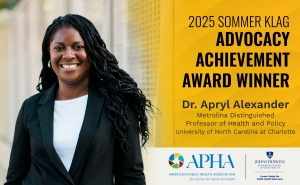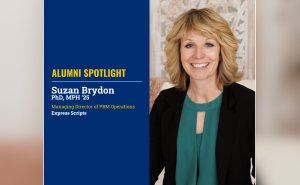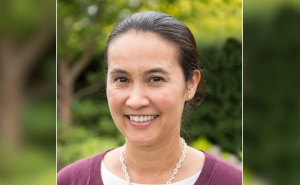OTC Narcan: A Win for Public Health
Making Narcan available over the counter puts the lifesaving medicine in everyone’s reach.

Narcan, the naloxone nasal spray used to reverse opioid overdose, was approved Wednesday for over-the-counter sale by the FDA. It's a major victory for harm reduction advocates and public health professionals—and a much needed step toward preventing thousands of overdose deaths each year. The CDC reports that almost half of fatal overdoses had a bystander present.
“This is a big win and long time coming,” says Sachini Bandara, PhD ’18, MS, an assistant professor in Mental Health. “Naloxone is one of the most effective strategies we have at preventing overdose deaths. At a time when overdose deaths are at an all-time high, it is critical that we reduce barriers to making Narcan readily available and this decision does just that.”
The approval means that “by late summer, over-the-counter naloxone will be available for sale at supermarkets, online retailers, chain stores,” she says.
“The increased availability of Narcan can only be a good thing. We need it to be everywhere, and for everyone to know how to use it,” says Travis Rieder, PhD, MA, an associate research professor at the Berman Institute of Bioethics.
But we have to be cautious not to reduce access to existing harm reduction programs and education, or contribute to naloxone shortages, says Health, Behavior and Society professor Susan Sherman, PhD ’00, MPH. “Hopefully [OTC Narcan] is a bonus, and not a replacement.”
How quickly Narcan’s sales catch on could depend on how readily it’s accepted by the public.
Bandara points out that “several counties [in Maryland] already had standing order prescriptions for Narcan in place," meaning pharmacists in those counties are legally allowed to to dispense naloxone, including any necessary supplies for administration, to anyone.
But “the fact that relatively few people kept it on them,” says Rieder, “says more about societal will than availability." There are still crucial obstacles to saving lives, he adds, like "the stigma that leads people to use drugs alone, the criminal laws that force them to hide, and some people’s disinterest in trying to help this population."
Sherman sees expanded availability of Narcan as a pathway to humanizing a marginalized population. “If you buy naloxone with the intention of using it on people that you may not even know,” she says, “you innately treat them as human beings.”
Strategic placement could help destigmatize Narcan’s purchase. In a tweet, Amesh Adalja, MD, recommended that it be available in public places, as fire extinguishers and AEDs are, or for sale in vending machines. Sherman says placing it on an end cap with educational materials would be ideal, adding that it’s an opportunity for “big chains that just had opioid settlements to do some good.”
But “in order for this policy to reach its full potential,” Bandara says, “it will be critical that the price of Narcan is affordable. Policies to address financial barriers to using naloxone, like subsidies, will be important.”
Now, the battle is to encourage the public to purchase—and use—the spray.
“We all need to double down on an effort to get people to buy it, carry it, store it in public places, and be willing to use it, if need be,” Rieder says.
And for skeptics who believe that the approval could encourage reckless substance use, Bandara points to a strong body of evidence showing that naloxone use does not increase drug use. Evidence also shows “that naloxone is safe and highly effective at reversing opioid overdose,” she says.
“At a time when overdose deaths are at an all-time high, it is vital that we make every effort to increase availability of this lifesaving tool.”
Morgan Coulson is an editorial specialist at the Johns Hopkins Bloomberg School of Public Health.
RELATED:
More from the Bloomberg School
- See latest headlines
- Learn more about our departments:





